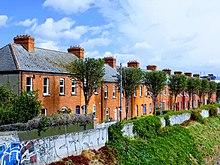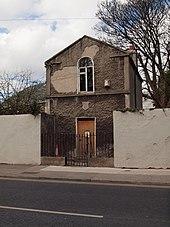Ballybough (Irish: An Baile Bocht, meaning "the poor town")[1] is an inner city district of northeast Dublin city, Ireland. Situated north of Summerhill Parade at Tom Clarke Bridge which separates Dublin 1 and Ballybough Village Dublin 3. Adjacent areas include the North Strand and Clonliffe.
History
Before its urbanisation in the late 19th century, Ballybough was known as Mud Island, owing to its proximity to the mud flats that now form Fairview and environs. Ballybough can be seen on the old maps as the original coast road now replaced by the North Strand Road.
There is an old Jewish cemetery, Ballybough Cemetery, on Fairview Strand near Ballybough Bridge (now renamed Luke Kelly Bridge) — the bridge that formed the central point of the Battle of Clontarf.[2] Inspired by this cemetery, Dublin poet Gerry McDonnell wrote his collection of poetry, 'Mud Island Elegy', on the Jewish community of Ireland in the 19th century. The local Roman Catholic church, Saint Agatha's, was built between 1878 and 1908.[3]
In the distant past, the Ballybough area attracted characters of ill-repute, drunks, prostitutes, and pirates. James Clarence Mangan used the pseudonym 'Peter Puff Secundus, Mud Island, near the bog’ to identify with the area. Here the authorities designated an area of burial known colloquially as 'the Suicide Plot' from which Bram Stoker derived the idea of the cross for his novel Dracula, the cross being the junction of Clonliffe Road and Ballybough Road.
During the land reclamation project of the 19th century, Mud Island was also known, interchangeably, as Friend's Field or French Field, before it became known by its current name. The village of Ballybough traces its origins to a series of small dwellings known as Ballybough Cottages, which were later demolished to make way for the Dublin Corporation housing project known as Ballybough House.
Stadium
Close by at Jones's Road is Croke Park, the headquarters of the Gaelic Athletic Association. This sports stadium is among the most modern in Europe with a capacity of 82,300. In addition to hurling and Gaelic football, it is used as a concert venue. Here U2 has played to some of its largest audiences. The stadium was where world boxing champion Muhammad Ali defeated 'Al Blue' Lewis in a non-title fight in 1972.
Notable residents
Luke Kelly of The Dubliners folk group, for whom Ballybough Bridge over the River Tolka is named, is from the area, as is film director Jim Sheridan (My Left Foot, The Field).
Curtis Fleming, from Tolka Road, played International football for Ireland as did Paddy Moore, from Clonliffe Avenue.
References
- ^ "An Baile Bocht / Ballybough". logainm.ie. Placenames Database of Ireland. Retrieved 8 January 2021.
- ^ Torchiana, Donald T. (22 December 2015). Backgrounds for Joyce's Dubliners. ISBN 9781317286844.
- ^ "Saint Agatha's Church , William Street North, Dunne Street, Dublin 1, Dublin City". buildingsofireland.ie. National Inventory of Architectural Heritage. Retrieved 8 January 2021.


_-_20180902102205.jpg)